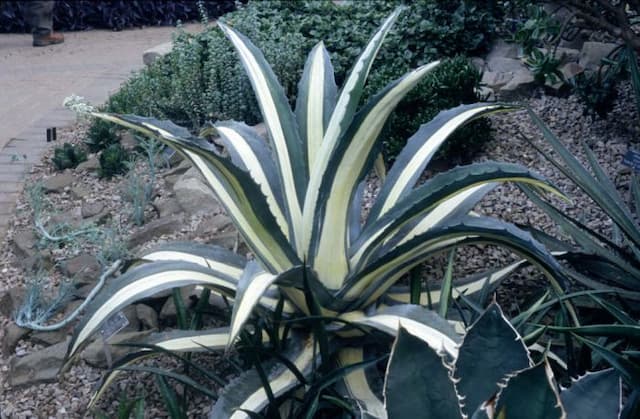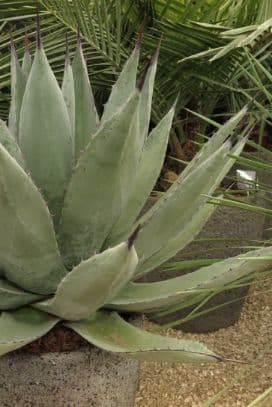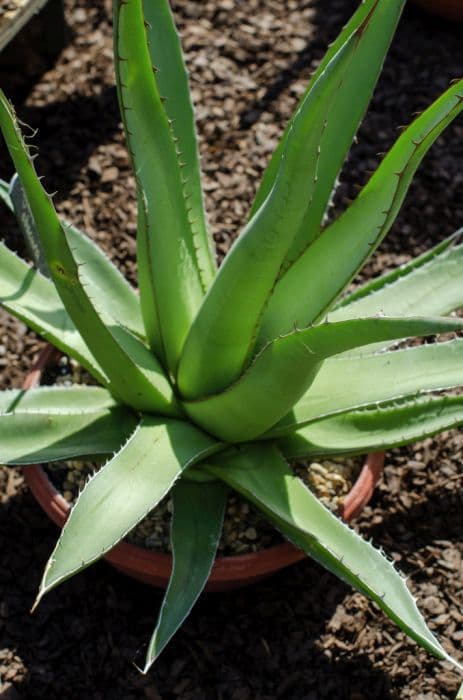Hosta Hosta 'First Frost' (v)

ABOUT
Hosta 'First Frost' is a perennial plant noted for its attractive foliage. The leaves are heart-shaped with a unique variegation pattern. They feature a blue-green center and are edged with a creamy yellow to white margin that tends to lighten and widen as the plant matures throughout the growing season. The leaves have a slightly puckered texture, giving them a somewhat corrugated appearance that can catch the light and create visual interest in shaded garden areas. In summer, the plant produces tall flower scapes that bear light lavender or pale purple bell-shaped flowers, adding an extra layer of color and decoration to the foliage display. The flowers are typically favored by pollinators like bees. This ornamental appeal, combined with its resilience and low-maintenance nature, makes Hosta 'First Frost' a popular choice for both novice and experienced gardeners looking to enhance the aesthetics of their garden spaces.
About this plant
 Names
NamesFamily
Hostaceae
Synonyms
Plantain Lily, Funkia
Common names
Hosta 'First Frost'
 Toxicity
ToxicityTo humans
The plant known as Hosta is generally not considered toxic to humans. However, it may cause mild stomach upset if ingested in large quantities. Symptoms are usually not severe and can include nausea, vomiting, and diarrhea. It is always recommended to keep plants out of reach of small children who might chew on them due to their attractive leaves.
To pets
Hosta plants are toxic to pets, specifically cats and dogs. If a pet ingests part of a Hosta plant, symptoms can include vomiting, diarrhea, and depression. In severe cases, ingestion can lead to more serious complications requiring veterinary attention. Pet owners should be vigilant and prevent their pets from accessing and ingesting these plants.
 Characteristics
CharacteristicsLife cycle
Perennials
Foliage type
Deciduous
Color of leaves
Variegated
Flower color
Lavender
Height
1 foot (30 cm)
Spread
2 feet (60 cm)
Plant type
Herb
Hardiness zones
3
Native area
Asia
Benefits
 General Benefits
General Benefits- Attractive Foliage: Hosta 'First Frost' features striking leaves that have a blue-green center with creamy yellow to white margins, adding visual interest to garden spaces.
- Shade Tolerance: This variety thrives in shaded areas where other plants might struggle, making it ideal for woodland gardens or shaded borders.
- Low Maintenance: Hostas are known for their ease of care, and 'First Frost' is no exception, requiring minimal maintenance once established.
- Long-Lasting: The foliage of 'First Frost' emerges in spring and lasts until the first hard frost, providing a long season of interest.
- Slug Resistance: 'First Frost' exhibits a resistance to slugs, a common pest for hostas, due to its thicker leaf substance.
- Drought Tolerant: Once established, it can tolerate periods of drought, although it prefers consistently moist soil.
- Cold Hardy: This cultivar is able to withstand cold temperatures and is suitable for growing in a range of climates.
- Versatile Garden Use: It can be used in a variety of landscapes, including borders, containers, and as groundcover, demonstrating great versatility.
- Seasonal Color Change: The margins of the leaves become more white as the season progresses, providing subtle changes in color and interest.
- Attracts Pollinators: While not noted for its flowers, the blooms of 'First Frost' can attract bees and other pollinators to the garden.
 Medical Properties
Medical PropertiesThis plant is not used for medical purposes.
 Air-purifying Qualities
Air-purifying QualitiesThis plant is not specifically known for air purifying qualities.
 Other Uses
Other Uses- Hostas can be used for creating natural dye for textiles, with 'First Frost' providing a unique color range depending on the parts of the plant used.
- The large leaves of Hostas can be used for wrapping food for cooking, adding a decorative and flavorful element to dishes.
- They can serve as a living mulch, suppressing weeds and retaining soil moisture when planted densely in garden beds.
- Hosta leaves can be used in flower arrangements as a lush, green backdrop to enhance the colors of other blooms.
- In garden design, Hostas can be used to create texture contrasts with their broad leaves against fine-leaved plants.
- Their thick foliage can be used to provide shelter and habitat for small garden wildlife such as frogs and beneficial insects.
- Oversized Hosta leaves can be used as a natural 'bowl' to serve dry snacks outdoors during garden parties.
- Creative gardeners can use Hosta leaves as a canvas, painting them for decorative purposes in the garden or as part of crafts.
- The seed pods of Hostas, when dried, can be used as part of ornamental winter displays in pots or garden beds.
- As a plant that can thrive in shade, Hostas can be used to green up dark corners of the garden, where other plants might struggle to grow.
Interesting Facts
 Feng Shui
Feng ShuiThe Hosta is not used in Feng Shui practice.
 Plant Symbolism
Plant Symbolism- Resilience: Hostas commonly symbolize resilience because they are hardy plants that can withstand various conditions.
- Endurance: Given its ability to survive the first frosts of the season, Hosta 'First Frost' represents endurance through tough times.
- Adaptability: Hostas can adapt to both shade and sunlight, making them a symbol for adaptability to life circumstances.
- Forgiveness: In some cultures, the Hosta is a symbol of forgiveness, as it returns each year even if it dies back in the winter.
- Devotion: The reliable perennial nature of Hostas represents devotion or loyalty in relationships.
 Water
WaterHostas, including 'First Frost', prefer consistent moisture and may need to be watered about once a week, providing roughly 1 inch of water which equals about 0.6 gallons per square yard of soil. Adjust the amount depending on rainfall, more during dry spells. Avoid overhead watering to minimize leaf wetness and reduce the risk of disease; instead, water at the base of the plant early in the day. During hot summer days, check moisture levels, as Hostas may need additional water. In the fall, reduce watering as the plant prepares for dormancy.
 Light
LightHostas, such as 'First Frost', thrive in partially shaded areas where they receive morning light and afternoon shade. They tolerate a range of light conditions, from full shade to a bit of direct sunlight, but avoid placing them in areas with intense afternoon sun, which can scorch their leaves. Dappled sunlight beneath trees is ideal to showcase their foliage.
 Temperature
TemperatureHostas like 'First Frost' are hardy and can tolerate temperatures down to about 30 degrees Fahrenheit but may suffer if the temperature drops below this point. They do best with daytime temperatures between 70 and 85 degrees Fahrenheit and nighttime temperatures between 60 and 70 degrees Fahrenheit. Hostas enter dormancy when temperatures start to consistently fall below 50 degrees Fahrenheit.
 Pruning
PruningPrune 'First Frost' Hostas to remove any damaged or spent leaves throughout the growing season to maintain plant health and appearance. In late fall or early winter, after the first frost, cut back the foliage to the ground to tidy up the garden and reduce the risk of disease in the next season. Pruning is typically done once a year, but spot cleaning of damaged leaves can occur as needed.
 Cleaning
CleaningAs needed
 Soil
SoilHostas prefer a well-draining, fertile soil with a pH range of 6.0 to 7.5. An ideal mix would be equal parts garden soil, peat moss, and perlite to ensure moisture retention and good drainage.
 Repotting
RepottingHostas, specifically 'First Frost', do not need frequent repotting. They can be repotted every few years or when you notice that the roots have completely filled the pot and are growing out of the drainage holes.
 Humidity & Misting
Humidity & Misting'First Frost' Hosta thrives in moderate humidity levels, typically between 50% to 70%, which mirror the natural humidity found in its native woodland habitats.
 Suitable locations
Suitable locationsIndoor
Ensure bright, indirect light and keep the soil moist.
Outdoor
Plant in partial shade; enrich soil with compost.
Hardiness zone
3-9 USDA.
 Life cycle
Life cycleHosta 'First Frost' begins its life as a dormant bare-root or potted plant, typically planted in spring or fall. Upon planting, root establishment and sprout emergence occur, where foliage begins to grow in a rosette-like pattern. As the season progresses, the plant develops broad, variegated leaves that form dense clumps, and it enters a stage of vegetative growth. In mid to late summer, Hosta 'First Frost' produces tall scapes topped with clusters of bell-shaped, lavender flowers, marking its reproductive phase. After flowering, the plant gradually prepares for dormancy as temperatures drop and day length decreases in the fall; foliage dies back, and the plant conserves energy in its root system. In subsequent years, the plant re-emerges from dormancy in spring, repeating its growth cycle and gradually increasing in size and clump width.
 Propogation
PropogationPropogation time
Early spring
Propogation: Hosta 'First Frost' is typically propagated by division, a method that is most successful when performed in early spring or early fall. To propagate by division, carefully dig up the plant when it is not in active growth, making sure to keep a substantial amount of roots attached. Gently separate the plant into smaller sections, each with at least two or three shoots and a corresponding portion of the root system. These divisions can then be replanted at the same depth they were growing at before, spacing them about 12 to 24 inches (about 30 to 60 centimeters) apart to allow for mature growth. Water the new divisions thoroughly after planting to settle the soil around the roots and help them establish.









